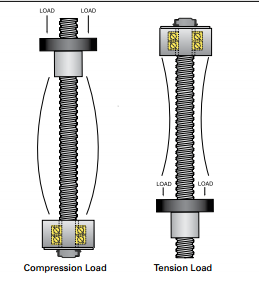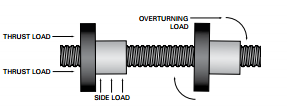Ball screws are known to encounter both compression and tensile loads. Compression loads tend to compress or squeeze the screw axially, which can make screws bow out. Tensile loads are those which tend to stretch the screw axially. While compression loading can be more problematic, tensile loading can cause the screw to elongate and crack. Knowing the direction the screw is loaded in as well as the end fixity helps when selecting screws as both critical speed and buckling need to be accounted for.
It’s important to mention that screws are only meant for thrust loading, or straight line axial thrust motion. Any type of overturning loading or side loading can immediately reduce the life of the screw by up to 90 percent.


